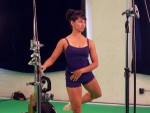Title
Science may not be the favorite subject of most performing artists. Yet an upcoming exhibit at the American Museum of Natural History, titled “Brain: The Inside Story,” draws viewers into the science behind our minds using a scenario familiar to nearly every performer: the audition process.
Body
The first stop in the exhibit, which opens on November 20, is a film that introduces the various elements of the brain and depicts an experience that hits especially close to home for the Juilliard community—that of auditioning for the Juilliard Dance Division. Written, directed, and produced by Sarah Galloway and featuring second-year dancer Lea Ved, the six-minute film will be displayed along with a six-foot long, three-dimensional model of the brain with internal lighting. As the story unfolds, the audience’s focus will be directed back and forth between the model and the video projection, alerting viewers to the different parts of the brain that play into each aspect of the highly charged audition.
The film is just one part of a labyrinthine exhibit addressing everything from how the brain enables perception to cutting-edge brain research to the plasticity that allows the brain to change throughout a lifespan. Beginning with a light-and-sound installation by the artist Daniel Canogar that mimics the brain’s neural pathways, visitors enter an alternate world where they can build and take apart a brain model, learn how the visual cortex is repurposed when someone goes blind, and explore the sounds of languages from around the world, among many other themes and activities. The exhibit ends with a “brain lounge” that includes comfortable seating, along with footage of musicians, athletes, and multilingual people and the data generated from functional MRIs (or fMRIs) of their brains.
Ved was chosen for the video installation following an audition that included questions about her own experience of trying out for Juilliard. A self-described science nerd, Ved said she wasn’t thinking about specific brain functions during her Juilliard audition, but she was aware of calming herself down—a key point in the exhibit video’s storyline.
The making of the film taught Ved not only about lights, cameras, and the intensity of a 10-hour shoot, but also about the inner workings of her mind as a dancer. “I can’t just differentiate it down to the molecular level, of course,” she said in a recent interview, “but I think I’m more aware of what I’m doing and what I’m perceiving and how I’m reacting to the things around me.” In the film, Ved is shown performing her own choreography.
For Galloway, the dance audition was a useful way to introduce viewers to elements of the brain referred to later in the exhibit. Instead of a matter-of-fact rundown of the brain’s anatomy, visitors will see, for example, that as Ved takes in her onstage environment, light hits her retina and signals are sent along the optic nerves leading to the brain’s visual cortex, where the signals are decoded. Ultimately, the dancer “sees” with her brain. From pre-performance jitters to the technique of visualizing a routine before performing, every part of the audition relates to processes within the brain. As Ved slows down her breathing and focuses her thoughts, the viewer sees that she is, in fact, priming the brain for performance.
The ups and downs of the audition process are, in part, what drew Galloway to the topic. “In order to perform at their best, [dancers] have to have a handle on their emotions and not let negative emotions come in and affect their performance,” she explained. She highlighted the correlation between concepts that are well-known in the dance world with scientific terms and facts. For example, what dancers refer to as muscle memory is known by scientists as procedural memory. When a dancer runs through a routine in his or her mind’s eye, activity in the brain looks the same as when the dancer actually performs the routine.
Whether rehearsing a symphony, memorizing a monologue, or learning a new language, how we use our brains plays a significant role in determining the outcomes of our efforts. “As anybody in the performing arts, or as anybody,” said Galloway, “there’s a lot you can get out of understanding your brain.”
Brain: The Inside Story will be on view from November 20, 2010, to August 14, 2011, at the American Museum of Natural History, Central Park West at 79th Street. For more information, visit amnh.org.





